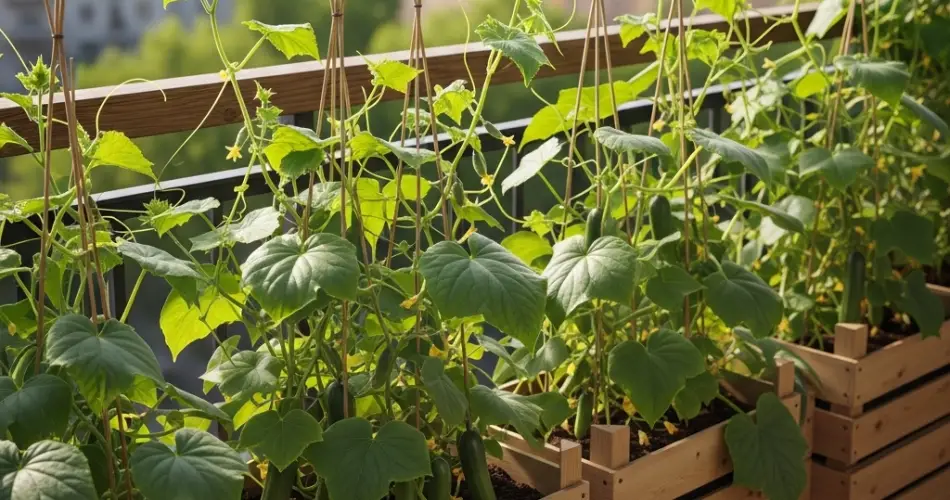Cucumbers are a refreshing and versatile vegetable that thrive when given proper care and growing conditions. Fortunately, you don’t need a traditional garden to enjoy a steady cucumber harvest. With a simple wooden crate and a little balcony or patio space, you can grow healthy, productive cucumber vines even in the most compact living areas.
Crate gardening is an efficient and attractive way to bring vegetables into urban homes. The method allows you to manage space, soil, and drainage effectively while giving climbing crops like cucumbers the vertical space they need to grow and produce fruit generously.
Why Grow Cucumbers in Crates?
Wooden crates are a great alternative to traditional garden beds or plastic pots. They offer several advantages for cucumber cultivation:
-
Good depth for root development
-
Excellent drainage to prevent waterlogging
-
Portability, allowing you to move the plant to follow the sun
-
Space efficiency when combined with vertical support
-
Rustic charm that fits well in balcony or patio setups
Crates also let you control the soil mix and easily manage pests and moisture—key factors in successful cucumber growing.
Choosing the Right Cucumber Variety
Cucumbers come in several types, but not all are suited to compact gardening. For crates, look for bush or compact vining varieties that don’t spread excessively.
Ideal varieties include:
-
Bush Champion – Compact and perfect for small spaces.
-
Spacemaster – Designed for container growing with short vines.
-
Patio Snacker – Crisp, slender fruits with a compact growth habit.
-
Poinsett 76 – Disease-resistant and manageable in containers with support.
-
Lemon cucumber – Small, round fruits that thrive in confined areas.
Opting for varieties that mature early and resist common cucumber diseases can make the process smoother and more productive.
Materials You’ll Need
To get started, gather the following supplies:
-
A wooden crate (at least 12 inches deep and 14–16 inches wide)
-
Landscape fabric or coconut liner
-
Potting soil (light, well-draining)
-
Compost or aged manure
-
Organic fertilizer (balanced or slightly nitrogen-rich to start)
-
Cucumber seeds or seedlings
-
Watering can or hose with gentle spray
-
Trellis, stakes, or bamboo poles
Ensure your crate has drainage holes or slats to allow excess water to escape.
Preparing the Crate
-
Line the inside with landscape fabric to retain soil while allowing drainage.
-
Fill the crate with a loose, nutrient-rich mix:
-
2 parts potting soil
-
1 part compost or aged manure
-
A handful of perlite or sand for added drainage
-
-
Incorporate slow-release fertilizer to support early growth.
Level the surface and moisten the soil before planting.
Planting Cucumbers
-
Start seeds indoors 3–4 weeks before transplanting or sow them directly into the crate after the last frost.
-
Sow 2–3 seeds per spot, about 1 inch deep. If using seedlings, space them 10–12 inches apart.
-
Thin seedlings to the strongest one per position once they sprout.
Position the crate in full sun—at least 6 to 8 hours of direct sunlight per day.
-
Install a trellis or vertical support system right after planting. Cucumbers climb readily and benefit from upward growth, which improves airflow, conserves space, and makes harvesting easier.
Watering and Feeding
-
Water consistently, keeping the soil evenly moist but not soggy. Cucumbers need plenty of water to grow plump and sweet.
-
Mulch the surface with dried leaves, straw, or coco coir to retain moisture and suppress weeds.
-
Feed every two weeks with a balanced organic liquid fertilizer. Once flowering begins, switch to a fertilizer with higher potassium to support fruiting.
Cucumbers are heavy feeders, so regular nourishment is key to a healthy yield.
Pest and Disease Management
Common cucumber issues include aphids, powdery mildew, and cucumber beetles. Use these preventive tips:
-
Spray neem oil or insecticidal soap at the first sign of pests.
-
Avoid overhead watering, which can encourage fungal problems.
-
Keep leaves dry and provide good airflow by pruning lower leaves and spacing plants properly.
Rotate crops between seasons and clean crates thoroughly to reduce disease risk year to year.
Harvesting Cucumbers
Cucumbers are usually ready for harvest 50–70 days after planting, depending on the variety. Pick them when they are:
-
Firm and smooth
-
6–8 inches long (for slicing types)
-
Bright green or golden yellow, depending on the variety
Harvest regularly to encourage more fruiting. Use scissors or garden shears to avoid damaging the vines.
Overripe cucumbers become seedy and bitter, so check your plants daily once fruiting begins.
Final Thoughts
Cucumber crate gardening is a smart, rewarding method for those with limited space but a desire for fresh, homegrown produce. With a little preparation and care, you can transform a small balcony or patio into a lush, vertical cucumber patch. Crates not only save space and improve drainage but also allow for creative, movable gardens that can thrive season after season. Whether you’re new to gardening or looking for a fun urban project, growing cucumbers in crates offers both beauty and a delicious harvest right outside your door.



